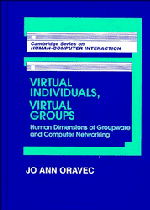Book contents
- Frontmatter
- Contents
- Dedication
- Overview
- Introduction
- 1 Evolution of computer application genres: Groupware and other network-based system applications
- 2 On the infinite variety of virtual entities
- 3 The shape of groups to come: Efforts to define, label, explain, and model collaborative activity
- 4 Shared resources and spaces: Lessons from the use of desks, tables, whiteboards, office settings, and video
- 5 Cultural objects and technological dreams: Dependence, autonomy, and intellectual augmentation
- 6 Privacy, anonymity, and agency: Applications of computer networking and the development of social analogues
- 7 Toward a genre-responsive design approach for computing applications
- Bibliography
- Author index
- Subject index
4 - Shared resources and spaces: Lessons from the use of desks, tables, whiteboards, office settings, and video
Published online by Cambridge University Press: 05 August 2011
- Frontmatter
- Contents
- Dedication
- Overview
- Introduction
- 1 Evolution of computer application genres: Groupware and other network-based system applications
- 2 On the infinite variety of virtual entities
- 3 The shape of groups to come: Efforts to define, label, explain, and model collaborative activity
- 4 Shared resources and spaces: Lessons from the use of desks, tables, whiteboards, office settings, and video
- 5 Cultural objects and technological dreams: Dependence, autonomy, and intellectual augmentation
- 6 Privacy, anonymity, and agency: Applications of computer networking and the development of social analogues
- 7 Toward a genre-responsive design approach for computing applications
- Bibliography
- Author index
- Subject index
Summary
In the end we design the tool for the material – in the end, but never in the beginning. In the beginning we have still to find out the first things about the ways in which the material is and is not workable; and we explore it by trying out implements with which we have already learned to work with other materials. There is no other way to start.
Gilbert Ryle, Dilemmas (1962,p. 66)The general conception of the ideal plant newspaper is pretty well defined… it should carry lucid articles on efficiency, personal betterment, shop news and personals, with the aim of securing cooperation.
Hi Sibley, Factory (April 1918, p. 776)As Ryle laments, the initial stages of design with a new “material” often amount to solving yesterday's problems and meeting yesterday's requirements. New possibilities and problems have indeed emerged in the era of CSCW applications. CSCW research and development communities have also taken on older, better-recognized, and still-important problems, problems with their predecessors addressed in efforts to shape groups with the use of artifacts. Several salient cultural objects appear to have traveled with all of these kinds of efforts, most notably that of “efficiency.”
A number of problems are associated with efforts to define or construct a group (in terms of its membership, sphere of action, and scope of accountability). Concern with these problems has surfaced in various forms since the early part of this century (as Sibley's advice in the epigraph suggests).
- Type
- Chapter
- Information
- Virtual Individuals, Virtual GroupsHuman Dimensions of Groupware and Computer Networking, pp. 148 - 188Publisher: Cambridge University PressPrint publication year: 1996



